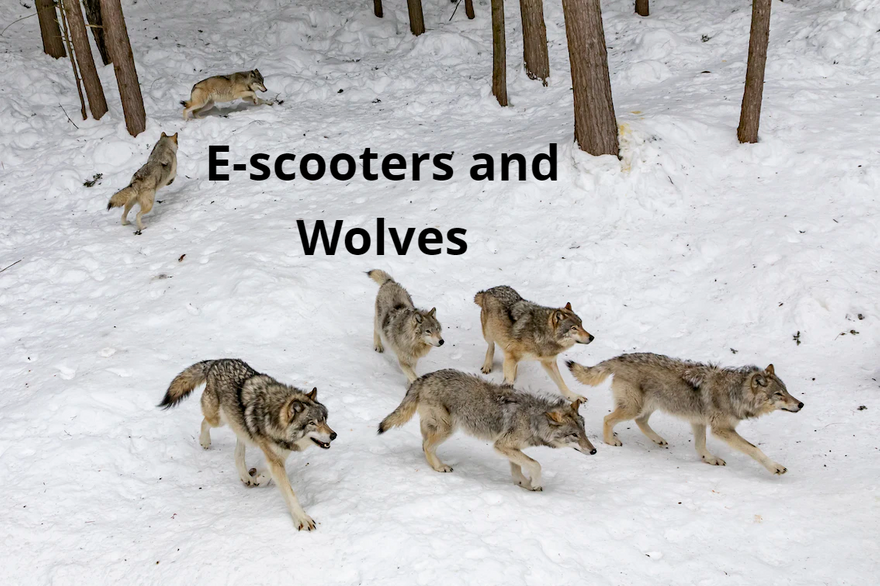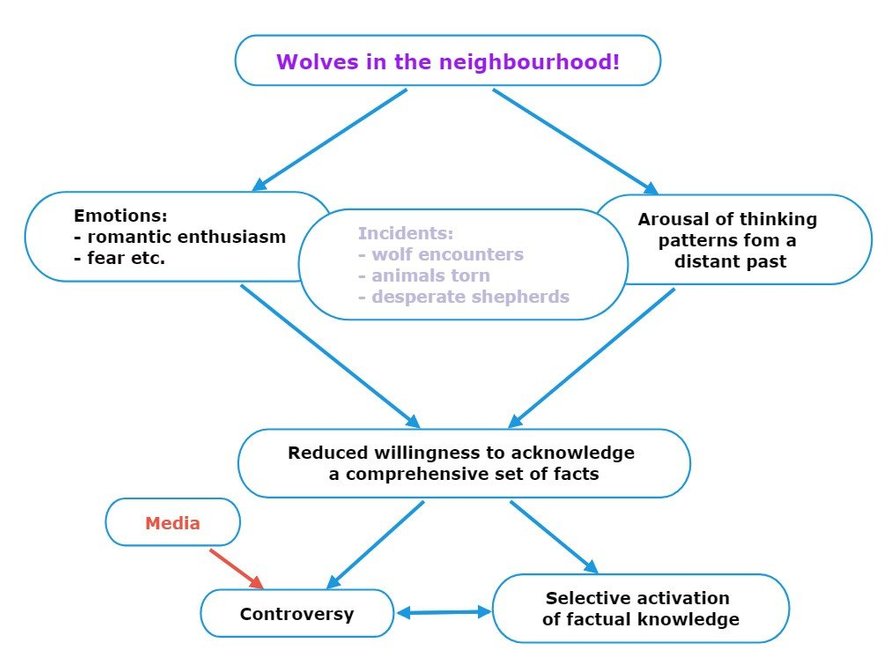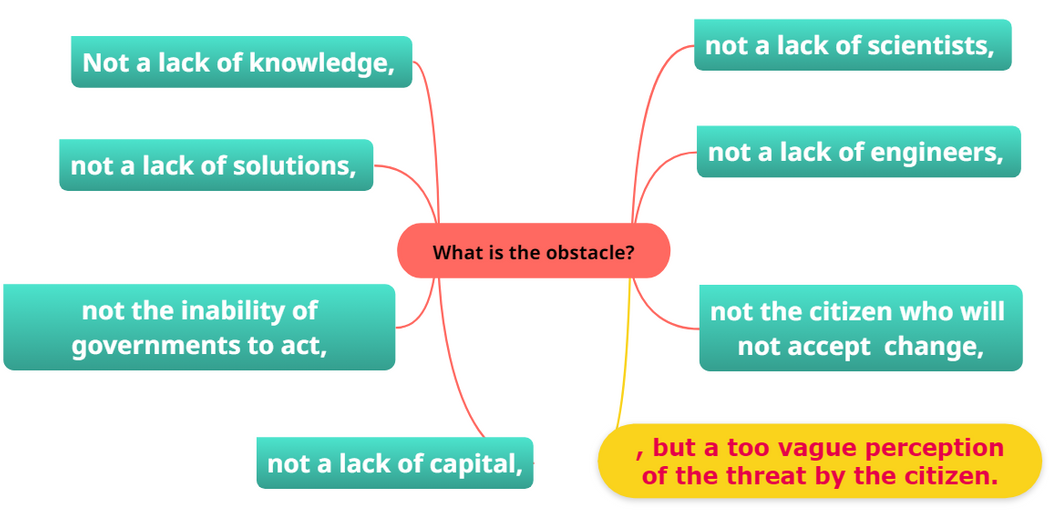Impulsive Thinking and what E-scooters and Wolves Teach us to Cope with it
Martin Bartels
19 May 2023
It is both exciting and instructive to see how a modern society that sees itself as open and agile reacts when material changes make it necessary to adjust the existing social consensus. Yet the path to a new state of equilibrium does not always follow logical rules. Deep-rooted habits of thought and emotional processes can hinder consensus formation especially with the emergence of different camps of opinion that inevitably confront each other with increasing animosity. Both the press and social media tend to exacerbate the polarity by pouring what amounts to jet fuel on the fire of public opinion.
To explore this phenomenon, I have chosen two controversial topics in Germany, the spread of rentable electric scooters in big cities and the return of wolves. In the first case, emotional responses have not won out and solutions are emerging. The second case is more challenging.
E-scooters
Since 2019, there has been a plentiful supply of e-scooters that you can rent via your mobile phone. Young people in particular like to take advantage of the offer and praise the possibility of being able to move around urban areas independently of public transport timetables and traffic jams, without causing emissions.
On the other hand, another segment of the population have taken issue with the e-scooters, as they encroach on the pavement at high speed. Furthermore, e-scooters are in many cases not parked properly, but simply left on the pavement, colonising much pedestrian space and being especially dangerous for elderly and visually impaired pedestrians who can easily trip over the unexpected obstacle. Another problem relates to the way that bikes are both visual and physical pollutants, and in quite a few cases, users of e-scooters have thrown them into bodies of water after use.
On 2 April 2023, the city of Paris held a legally non-binding referendum on whether to renew the licences it has granted to providers of rentable e-scooters. Following a broad majority against e-scooters, the city council agreed to let the licences expire on 31 August. This example has impressed e-scooter opponents in Germany.
However the debate is not over yet. For a rational assessment, we still need to know
- The ecological cost of e-scooters. While they certainly emit less direct emissions, a true reckoning of their environmental cost would need to take into account the impact of their manufacturing including components, battery charging, maintenance, the average lifetime of the means of transport (less than 2 years) and how such devices are disposed of at end of life.
- The direct damages (death, injuries, treatment costs) and consequential damages (loss of working hours, rehabilitation costs) caused by accidents. There are statistical evaluations for this. The age groups of road accident victims (one third is under 25) and the most common causes of accidents (often alcohol) must also be taken into account.
Factual evaluation of e-scooters and decision-making, no yelling
Decisions on issuing licences like in Paris are made by city councils, not by groups of citizens who are hostile to each other. The public administration is held to assess, according to objective criteria, under which conditions a business such as the rental of e-scooters can be operated. For example, a license can be granted so that the city can charge rental companies a flat fee for each incorrectly parked device, fees that these companies can pass on to their customers. Regulation can also involve police imposing spot fines for driving on the pavement or driving while inebriated. Municipalities can thus set effective impulses for civilised behaviour. If such measures are not sufficient, then short of outright banning, there is the possibility of making licences so expensive that the financial incentive for e-scooter rental companies is removed.
The bottom line is that at the technical level, administrations have a good chance of disempowering groups of citizens who are bent on disputes among themselves. They can analyse issues in a balanced way and establish a common denominator. And they can change their decisions later when relevant or new aspects to an issue are discovered. In this case, resistance to administrative decisions will not be massive because the group of enthusiastic e-scooter riders is manageable and has not mobilised a strong lobby politically.
Wolves returning
Wolves were a part of Europe’s natural landscapes until the 19th century when industrialisation, agricultural innovations and increases in population led to the consensus that wolves were a disturbance. In 1879, a forester in the Hunsrück region killed the last wolf living in Germany.
Since the end of the Cold War, there has been a growing migration of wolves from the east of the continent, beginning with loners and eventually packs. As of 28 November 2022, 161 packs, 43 pairs and 21 individuals were officially reported in the country. This does not include the number of pups. There will also be a number of unreported cases. The population is growing rapidly.
Much yelling
Debates on the topic of "wolves" in personal circles and in public heat up quickly. They can be amazingly upsetting. Usually they follow this pattern
The unfortunate thing is that after such debate heats up, it can be difficult to simmer things back down again. Confirmation bias, the tendency to only seek out information that backs up pre-existing beliefs, rules supreme and quarrels become ever more bitter. Rising adrenaline levels on all sides are the worst preconditions for finding reasonable solutions with the media, fuelled by controversy, encouraging the argument.
Who are the stakeholders
(a) The “pro-camp”
- There are dedicated nature conservationists who are firmly committed to the restoration of what they see as the natural state of things. Their basic premise is that humans must learn to live together with wolves in a harmonious way. They are professionally organised in the “Nature Conservation Union” .
- There are many people who react enthusiastically and romantically to the return of wolves to Western Europe. This emotional and sentimental association of modern Europeans with wolves may be a re-emerging remnant from vanished Indo-European shamanistic imaginaries. They celebrate 13 August as the “International Wolf Day”. Perhaps Sergei Prokofiev contributed a little to creating the image of the placid relationship between humans and wolves.
(b) The “anti-camp”
- Shepherds are the most affected stakeholders, because wolves have a preference for sheep. As a rule, wolves do not kill only one animal to consume the meat, thus Shepherds typically find a large number of dead or dying animals in the morning after the wolves have lived out a bloodlust. Low-income shepherds are urged to protect their flocks with tall electric fences and trained livestock guardian dogs or Kangal dogs. These are expensive. Compensation paid by the state for animals killed does not cover the damage because the surviving animals are persistently traumatised. The recommended protective measures are heavy financial burdens for them and may be unaffordable. Shepherds may also become mentally affected by attacks on their sheep and end up giving up their flocks.
- Horse and pony holders: There have been attacks by wolves on horses in the pasture or when riding out with the rider. A wolf killed a pony belonging to the President of the EU Commission, Ursula von der Leyen.
- Cattle farmers
- Dog owners
- Cyclists: Recently, three wolves chased a young woman who was on her way to work on her e-bike. She was able to escape danger with the help of the turbo gear.
- Even though there has not yet been an attack, it’s hard to reason with parents whose children have to be calmed down when their children encounter a wolf on the way to school. Parents do not accept arguments like "low probability" when a wolf appears in front of a primary school. There is a correlation between wolf attacks and rabies.
- The search for wolf attacks on e-scooter drivers was unsuccessful, even though the first wolves have been seen in suburbs. However, there are e-scooters that have included the term "wolf" in their brand name. May they all travel safely!
(c) The public sector: European Union, federation, federal states, judiciary
- The European "Habitats Directive" is the basis for the legislation of the member states. The Federal State in its capacity as legislator has adopted the concept of wolves as a healthy part of nature and placed the wolf under conservation at the national level . This means that wolves may only be shot in extremely exceptional cases. The state ensures enforcement through hunting authorities and forestry authorities. Unauthorised shooting results in criminal prosecution and the rules are strictly applied.
Towards a more comprehensive set of facts
In the middle of the 19th century, the privilege of the aristocracy to hunt in the forests ended. At the same time, state-controlled management of the forests without wolves began. It had and still has the goal of preserving the total area of the forests and maintaining them while satisfying the needs of the timber and agricultural industries. The exception are smaller national parks that correspond to the landscapes before nature was cultivated.
The state administration and hunters, on instruction of the authorities, have successfully developed a managed minimally invasive ecosystem which is sometimes designated as a "cultural landscape". Hunters are only allowed to operate during set seasons, and they may only shoot with prior permission of the local hunting authority. They are a reliable pillar of landscape management.
Wolves are predators and their dispositions have not changed since the last time they inhabited western Europe. Attacks on humans are not likely, but not entirely out of the question. There is careful French documentation of human casualties in the past centuries. And there is a global list of reported incidents extending to the present time.
The incidents mentioned above do not meet the requirements of comprehensive statistics. We have to qualify them as not more than "anecdotal evidence". However, when it comes to issues of safety, especially for humans, such incidents cannot be dismissed as irrelevant.
Nonetheless it is fair to conclude that a freely reproducing wolf population is:
- an interference with the hitherto well-performing management of “cultural landscapes”.
- a risk factor for humans and their animals.
Looking ahead
The serious question we need to address is whether wolves make a valuable contribution to maintaining the ecological balance in the “cultural landscapes” where deer and other ungulates would otherwise destroy forests through overgrazing. Included in this question is the hypothesis that hunting authorities, which have been responsible for managing ecosystems for more than 150 years and issue shooting permits to hunters and foresters according to their observations and calculations based on experience, contribute less to the environment and society than wolves.
Hypotheses can be confirmed or refuted by facts. If they cannot be supported by facts, then we should look towards the potential outcomes we can ascertain and whether the risk is worth it. The political options available, from taking no action to reducing the number of wolves or to eliminating the population thus should be weighed up as to what we believe would cause the least damage.
There are signs that some German federal states have begun to study facts and conduct deeper empirical research. They may decide to facilitate the shooting of wolves identified as dangerous by means of ordinances. This would mean a soft intervention. The federal state of Bavaria has recently decided to go this route.
A sudden and most unfortunate impulse to action would be felt by all European states if there were a fatal wolf attack on a human. Think of the poor 26-year-old jogger who was horribly killed by a bear in Trentino-Alto Adige a few weeks ago. The bears had been introduced to the area about 20 years ago with the aim of strengthening biodiversity.
So how does this all relate to e-scooters? We could say that e-scooters and wolves are both invasive species. The impulse to simply welcome them is as understandable as it is hasty. The two issues allow us to reflect on how much damage society must suffer before a serious decision-making process is set in motion. However, reason has a hard time making its way through powerful collective feelings.
The public sector is bound to the common good. Feelings are to be taken into account, but these must not override the necessity to protect the citizens’ health and lives. E-scooters pose a manageable threat. But the public sector will need to carefully review its current pro-wolf legislation in light of aggregated and ascertained data.
Authorship disclosure:
Fully human generated


